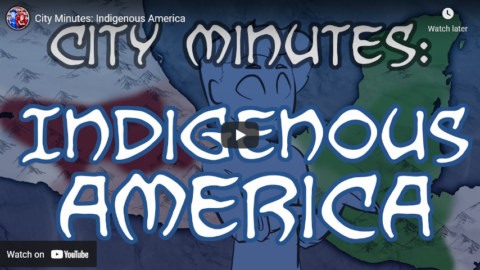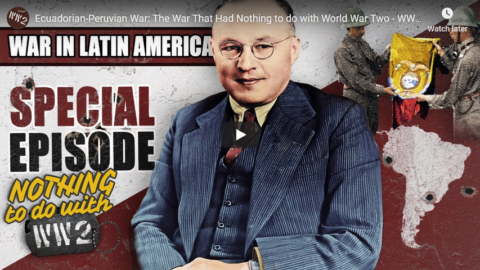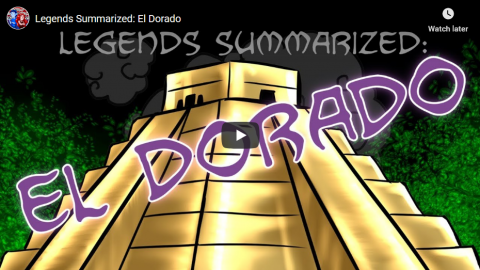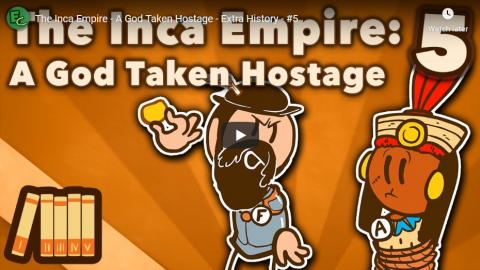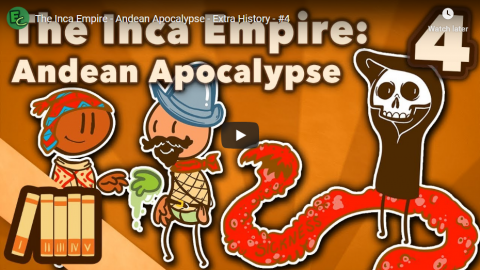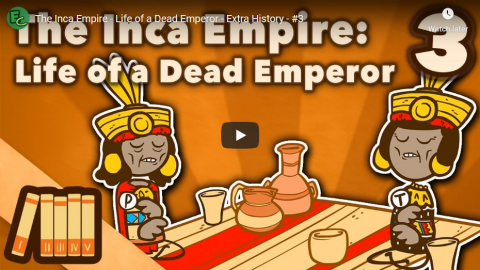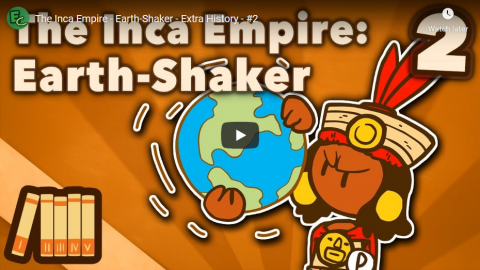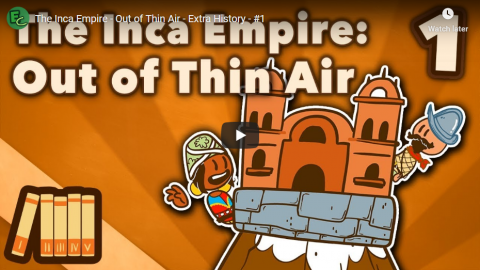Overly Sarcastic Productions
Published 15 Oct 2021As we look at four pre-Columbian American cities, I don’t know whether to be more impressed with the the architecture or the landscaping. Probably both.
More Indigenous Myths & History:
The Five Suns (https://youtu.be/dfupAlon_8k)
Quetzalcoatl (https://youtu.be/451jzIesWoU)
Huitzilopotchli (https://youtu.be/Zj-jDOjBets)
El-Dorado (https://youtu.be/UHzkGueRz3g)
Pele (https://youtu.be/q1z19p48lZU)
Hawaii (https://youtu.be/xYouQESFE2A)Teotihuacan shirt: https://www.redbubble.com/shop/ap/903…
Timestamps:
0:00 – 1:03 — Teotihuacan
1:03 – 2:04 — Tikal
2:04 – 3:00 — Tenochtitlan
3:00 – 4:08 — Cusco
4:08 – 5:20 — ConclusionSOURCES & Further Reading: The Great Cities in History by John Julius Norwich, The Great Courses lectures “The Great City of Teotihuacan” and “Tikal – Aspiring Capital of the Maya World” and “The Aztec Capital of Tenochtitlan” from lecture series Maya to Aztec: Ancient Mesoamerica Revealed by Edwin Barnhart, and “Machu Picchu and the Sacred Valley” and “The Inca – From Raiders to Empire” from lecture series The Lost Worlds of South America by Edwin Barnhart.
Our content is intended for teenage audiences and up.
PATREON: https://www.Patreon.com/OSP
PODCAST: https://overlysarcasticpodcast.transi…
DISCORD: https://discord.gg/osp
MERCH LINKS: http://rdbl.co/osp
OUR WEBSITE: https://www.OverlySarcasticProductions.com
Find us on Twitter https://www.Twitter.com/OSPYouTube
Find us on Reddit https://www.Reddit.com/r/OSP/
October 16, 2021
City Minutes: Indigenous America
September 11, 2020
Ecuadorian-Peruvian War: The War That Had Nothing to do with World War Two – WW2 Special
World War Two
Published 10 Sep 2020While the Second World War grows ever more destructive, some nations take advantage of the global chaos to settle old disputes. In Peru and Ecuador, long standing territorial disputes turn violent.
Join us on Patreon: https://www.patreon.com/TimeGhostHistory
Or join The TimeGhost Army directly at: https://timeghost.tvFollow WW2 day by day on Instagram @ww2_day_by_day – https://www.instagram.com/ww2_day_by_day
Between 2 Wars: https://www.youtube.com/playlist?list…
Source list: http://bit.ly/WW2sourcesHosted by: Indy Neidell
Written by: Francis van Berkel
Director: Astrid Deinhard
Producers: Astrid Deinhard and Spartacus Olsson
Executive Producers: Astrid Deinhard, Indy Neidell, Spartacus Olsson, Bodo Rittenauer
Creative Producer: Joram Appel
Post-Production Director: Wieke Kapteijns
Research by: Marlon William Londono and Lewis Braithwaite
Edited by: Mikołaj Cackowski
Sound design: Marek Kamiński
Map animations: Eastory (https://www.youtube.com/c/eastory)Colorizations by:
Carlos Ortega Pereira, BlauColorizations, https://www.instagram.com/blaucolorizations
Mikolaj UchmanSources:
David Rumsey Map Collection, David Rumsey Map Center, Stanford Libraries
ecured.cu
From the Noun Project: Artillery by Creative Mania, engineer by Eucalyp, company soldiers by Andrei Yushchenko, Horse by RIZCASoundtracks from the Epidemic Sound:
Rannar Sillard – “March Of The Brave 4”
Johannes Bornlof – “The Inspector 4”
Fabien Tell – “Last Point of Safe Return”
Reynard Seidel – “Deflection”
Philip Ayers – “Trapped in a Maze”
Johannes Bornlof – “Deviation In Time”Archive by Screenocean/Reuters https://www.screenocean.com.
A TimeGhost chronological documentary produced by OnLion Entertainment GmbH.
October 5, 2019
Legends Summarized: El Dorado
Overly Sarcastic Productions
Published 4 Oct 2019El Dorado! A shining golden city packed with promises of wealth, power and everlasting glory. An unspoiled paradise deep in the jungle, the PERFECT destination for treasure-hunters and anthropologists alike. Something that perfect is something EVERYONE wants to be real.
Aaaaand that’s the trick, isn’t it? Wanting something that badly isn’t healthy. Just ask the conquistadors!
(Oh wait, we can’t – because so many of them died on fruitless quests for El Dorado. And also it’s been five hundred years and they’d all be dead anyway)PATREON: https://www.Patreon.com/OSP
MERCH LINKS: https://www.redbubble.com/people/OSPY…
OUR WEBSITE: https://www.OverlySarcasticProductions.com
Find us on Twitter https://www.Twitter.com/OSPYouTube
Find us on Reddit https://www.Reddit.com/r/OSP/
September 22, 2019
The Inca Empire – A God Taken Hostage – Extra History – #5
Extra Credits
Published on 21 Sep 2019Join us on Patreon! http://bit.ly/EHPatreon
Atahualpa vs. Francisco Pizarro. The Incas had never seen horses before, and it wasn’t long before the Spanish had captured Atahualpa as a hostage for gold and silver. But Atahualpa had a plan. He found a way to use this situation to his own political advantage — and Pizarro eventually destroyed himself through his greed and violent carelessness that appalled the Spanish government, eventually allowing the Incas to thrive again.
Follow us on Instagram: http://bit.ly/ECisonInstagram
September 16, 2019
The Inca Empire – Andean Apocalypse – Extra History – #4
Extra Credits
Published on 14 Sep 2019Join us on Patreon! http://bit.ly/EHPatreon
Disease — likely, smallpox or measles — had arrived in the Inca empire, and it was ruthless. Two of the (now dead) Emperor Huayna Capac’s sons, Atahualpa and Huáscar, decided that a civil war over who should be Sapa Inca was perfect to do right now — nevermind the fact that Francisco Pizarro and his conquistadores had just showed up.
September 9, 2019
The Inca Empire – Life of a Dead Emperor – Extra History – #3
Extra Credits
Published on 7 Sep 2019Join us on Patreon! http://bit.ly/EHPatreon
To understand daily life in the Inca Empire, we travel from Cusco to Quito (located in modern-day Ecuador), where Thupa Inca wanted to establish a second capital city. From efficiently designed work assignments, to elaborate death rituals, life was neatly organized, masking rising tensions.
September 2, 2019
The Inca Empire – Earth-Shaker – Extra History – #2
Extra Credits
Published on 31 Aug 2019Join us on Patreon! http://bit.ly/EHPatreon
Pachacuti, the Earth-Shaker, was the ninth leader of the Inca and the one who took the ambitions of the city of Cusco into an all-out military campaign to expand the empire — alongside bribing and engineering and negotiating their way to expansion.
Pachacuti turned out to be a good name for this ninth ruler of the Inca, because while the name did mean “earth-shaker” it was also a philosophical concept. In Quechua, the Inca’s primary language, a pachacuti was a historic event, a cataclysm that overturns space and time, remaking the world. It was a good title for the man who would forge the Kingdom of Cusco into an empire.
August 26, 2019
The Inca Empire – Out of Thin Air – Extra History – #1
Extra Credits
Published on 24 Aug 2019Join us on Patreon! http://bit.ly/EHPatreon
There’s a lot that we don’t know for sure about the Inca Empire, because we have conflicting accounts among Spanish colonizers, as well as the fact that Inca history itself is told non-linearly. But we do know that they used Andean accomplishments, from architecture to knotted quipu, to create a city that ruled the largest indigenous empire in the Americas, starting with Manco Capac and the successive Sapa Inca rulers.
August 20, 2018
Causes of Inflation
Marginal Revolution University
Published on 24 Jan 2017In the last video, we learned the quantity theory of money and its corresponding identity equation: M x V = P x Y
For a quick refresher:
•M is the money supply.
•V is the velocity of money.
•P is the price level.
•And Y is the real GDP.
In this video, we’re rewriting the equation slightly to divide both sides by Y and explore the causes behind inflation. What we discover is that a change in P has three possible causes – changes in M, V, or Y.
You probably know that prices can change a lot, even over a short period of time.
Y, or real GDP, tends to change rather slowly. Even a seemingly small jump or fall in Y, such as 10% in a year, would signal astonishing economic growth or a great depression. Y probably isn’t our usual culprit for inflation.
V, or the velocity of money, also tends to be rather stable for an economy. The average dollar in the United States has a velocity of about 7. That may fall or rise slightly, but not enough to influence prices.
That leaves us with M. Changes in the money supply are the driving factor behind inflation. Put simply, when more money chases the same amount of goods and services, prices must rise.
Can we put this theory to the test? Let’s look at some real-world examples and see if the quantity theory of money holds up.
In Peru in 1990, hyperinflation came into full swing. If we track the growth rate of the money supply to the growth rate of prices, we can see that they align almost perfectly on a graph with both clocking in around 6,000% that year.
If we plot the growth rates of the money supply along with the growth rates of prices for a many countries over a long stretch of time, we can see the same relationship.
We’ll wrap-up the causes of inflation with three principles to keep in mind as we continue exploring this topic:
•Money is neutral in the long run: a doubling of the money supply will eventually mean a doubling of the price level.
•“Inflation is always and everywhere a monetary phenomena.” – Milton Friedman
•Central banks have significant control over a nation’s money supply and inflation rate.
July 14, 2018
Hernando de Soto Knows How To Make the Third World Richer than the First
ReasonTV
Published on 13 Jul 2018The Peruvian economist says blockchain technologies and social media will transform the planet by securing property rights.
—————-In the spring of 1989, Chinese students occupied Tiananmen Square, erected a replica of the Statue of Liberty, and called for democracy and individual rights. By the fall, people living in East Germany took hammers and chisels to the Berlin Wall, unleashing a wave of revolutions that ultimately led to the collapse of the Soviet Union. It was an auspicious year for human freedom.
Nineteen eighty-nine was also the year that Peruvian economist Hernando de Soto published The Other Path: The Invisible Revolution in The Third World, which radically challenged conventional wisdom about the underlying cause of persistent poverty in the post-colonial landscape. Drawing on his extensive field work with the Peruvian-based think tank the Institute for Liberty and Democracy, de Soto argued that people were pushed into the black market and wider informal economy because governments refused to recognize, document, and promote legal ownership of land and other assets.
Without clear title and the right to transfer property, common farmers understandably refused to invest much in the land they tilled, and they couldn’t use it as collateral. This created what de Soto later called “citadels of dead capital” with value that could never be fully accessed.
No one, he argued, would plan for the future if everything they accumulated could just be taken away. As much an activist as an intellectual, De Soto has been called “the world’s most important living economist” by former President Bill Clinton. He is credited with changing policy in Peru and elsewhere by pushing governments to create property regimes that are public, transferable, and secure. His latest endeavor is a partnership with Overstock.com founder Patrick Byrne and others to use blockchain technology and social media to create totally public and perfectly transparent records of ownership.
Reason‘s Nick Gillespie caught up with de Soto in Washington, D.C. in June, where he received the Competitive Enterprise Institute’s Julian L. Simon Memorial Award, named for the late free-market economist who believed that “mankind is the ultimate resource.”
May 3, 2017
“Poverty, to be scenic, should be rural”
Daniel Hannan on the contrast between rural and urban poverty, and the attitudes of Westerners:
When I was growing up in Lima in the 1970s, Western visitors were astonished by the shantytowns, the barriadas, as they were known, that ringed that grimy city. Why, they asked, did people leave the countryside to live in these squalid slums? Why swap the pure air of the Andes for traffic fumes and sewage?
It was a very First World question. No Peruvian ever asked why people were quitting villages that lacked electricity and clean water. The barriadas may have been ugly, but they were humming with enterprise. They offered work, access to schools and clinics, a power supply. They were, for most of their denizens, transitional, a staging post between mountain squalor and something better.
In time, I came to realize that Western nose-wrinkling at developed countries was more esthetic than sympathetic. As the Victorian novelist Anthony Trollope put it, “Poverty, to be scenic, should be rural.”
Western attitudes haven’t advanced much since then. My kids’ geography homework is full of stories about evil Western corporations exploiting poor women in Vietnam or wherever. Now, you and I would not want to work in a Vietnamese sweatshop. But we have not spent our lives bending our backs in rice paddies.
Employees of foreign-owned companies in Vietnam earn 210 percent of the average wage. The readiness of that country to open itself to trade and investment has brought huge benefits to the Vietnamese, including those on the lowest incomes. Over 19 years, the West struggled to defeat totalitarian socialism in Vietnam, and failed. Three decades of trade have achieved what 60,000 American lives and over a trillion dollars in today’s prices in military spending failed to achieve: the end of Communism.
Developing countries which open their markets eliminate poverty more quickly than those which don’t. Compare Vietnam to Myanmar, or Colombia to Venezuela, or Bangladesh to Pakistan. A study of developing states since 1980 showed that those which had joined the global trading system enjoyed annual growth at an average of 5 percent, as against 1.5 percent for those which hadn’t.
February 4, 2017
Simón Bolívar – VI: All Good Things – Extra History
Published on Dec 24, 2016
Simón Bolívar hoped to bring the nations of South America together in one great federation, but he feared that people would think he meant to make himself a king. He tried to step back, but revolution threatened from within his ranks and his body had grown weak with illness.
January 30, 2017
Simón Bolívar – V: Heavy is the Head – Extra History
Published on Dec 17, 2016
After so many failures, Simón Bolívar finally began to find success: Gran Colombia, Peru, and Bolivia all stood free from Spanish rule. He raced to found new governments and consolidate the liberty he’d earned, but resources had been stretched too thin.
January 25, 2017
Simón Bolívar – IV: Defeat is Not Surrender – Extra History
Published on Dec 10, 2016
Failure had taught Simón Bolívar one important lesson: no single state in Spanish South America could win independence alone. To succeed, he needed to form one great state, united and able to stand up to the might of Spain.
October 30, 2014
“Free Trade” deals usually have little to do with actual free trade
It’s not exactly a revelation that what politicians call “free trade” agreements are usually tightly constrained, regulated, and micro-managed trade: almost the exact inverse of what a genuine free trade deal would look like. This is primarily because politicians and diplomats have hijacked the original term to describe modern mercantilism. In The Diplomat, Ji Xianbai looks at how so-called free trade negotiations are little more than diplomatic beat-downs of the weaker parties by the stronger:
The classic mercantilism, the one associated with the idea that the precious metals obtained through a favorable balance of foreign trade were essential to a powerful nation, may be historically obsolete. The core of the mercantilist view, namely that self-interested states maximize economic development by optimizing political control to strengthen national power, is very much alive and well. Indeed, the vitality of mercantilism as a state of mind may have infiltrated every corner of the international political economy. If one considers the essence of mercantilism through Robert Gilpin’s definition – the attempt of governments to manipulate economic arrangements in order to maximize their own interests – multiple examples immediately come to mind: Japan’s “economic totalitarianism” system in which the entire society was united in deterring foreign competition in the postwar period, China’s ascendance since 1980s through an export-led development mode underpinned by a deliberately undervalued currency, and Germany’s unprecedented trade surplus accrued from the stringent austerity imposed on its economy to sustain competitiveness in the aftermath of the euro crisis.
Compared to those national triumphs of classic mercantilism, there is a less visible showroom, but one in which mercantilism presents itself over and over again in the form of legal mercantilism. This would be free trade agreements (FTAs), negotiations of which are usually kept in the dark. In bilateral FTA negotiations, legal mercantilist governments endeavor to impose their own (or desirable) trade rules and economic policies on other sovereign countries, usually with the aid of a combination of economic immensity, political hegemony, and asymmetric trade dependence, to create a sort of “international best practice,” favorable trade rules, and legal gains that can be leveraged and multilateralized at a regional and/or global level. The “competitive liberalization” strategy aptly pursued by the U.S. since 2002 is one such legal mercantilist policy, which aims to create another “gold standard” in international trade standard setting to project U.S.-friendly economic policies all over the world. In short, the U.S. expects the trade policies of other nations to follow those of the U.S., in the same way that their currencies used to peg to the U.S. dollar.
The U.S.–Peru FTA (PTPA) marks the very first success of Washington’s attempts to subordinate other countries’ sovereignty to its own national interest by squeezing non-trade-related provisions into a bilateral trade liberalization agreement and overriding foreign national laws. To provide a level playing field for American companies, the PTPA lays out detailed measures that Peru is obliged to take to govern its forest sector. The Forest Annex of the PTPA requires Peru to set up an independent forestry oversight body and even enact new Forestry and Wildlife Laws to legalize key provisions of PTPA. The U.S.–Colombia FTA (CTPA)’s labor provisions represent an “even more blatant assault on another country’s sovereignty.” Meanwhile, Colombia was forced to agree to establish a dedicated labor ministry; endorse legislations outlawing interference in the exercise of labor rights; double the size of its labor inspectorate; and set up a phone hotline and an internet-based system to deal with labor complaints. Examples of similar provisions abound: Don’t forget that the U.S.-Panama FTA has “helped” revamp Panama’s tax policy on behalf of Panamanians.

